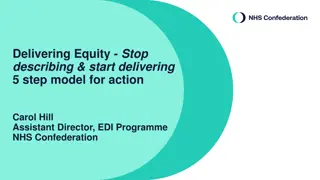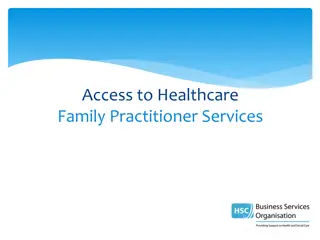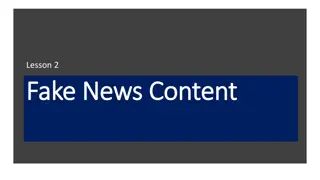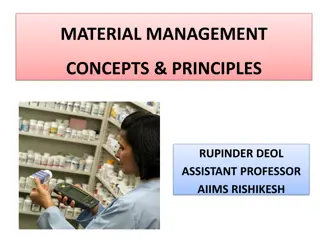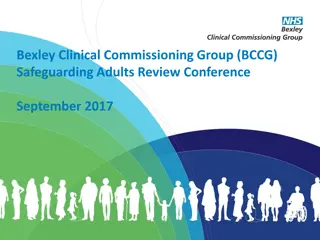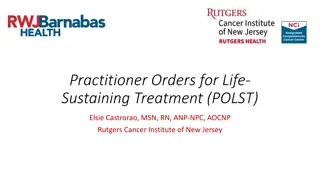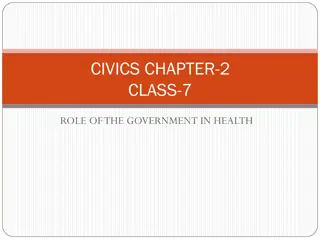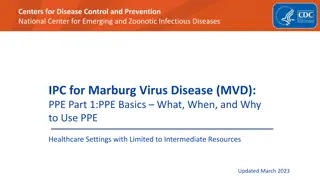Delivering Bad News in Healthcare: Importance and Strategies
Communicating bad news in healthcare is a challenging yet crucial aspect of patient care. From breaking terminal diagnoses to managing patient distress, physicians must approach these situations with empathy, sincerity, and clear communication. This article discusses the importance of delivering bad news, key strategies, and the emotional aspects involved in such conversations.
Download Presentation

Please find below an Image/Link to download the presentation.
The content on the website is provided AS IS for your information and personal use only. It may not be sold, licensed, or shared on other websites without obtaining consent from the author. Download presentation by click this link. If you encounter any issues during the download, it is possible that the publisher has removed the file from their server.
E N D
Presentation Transcript
Breaking bad news BY: OUF ALOOFY 434103053 SAUD ALHAIDAR 434101767 ABDULAZIZ ALFRAIJI 434104036
Objectives: Reasons communicating bad news is important. Strategy approaches to deliver bad news. Examples how to break news. Role play.
What Is Bad News? Any news that drastically and negatively alters the patient s view of her or his future . Breaking bad news is one of a physician s most difficult duties.
Bad news is stereotypically associated with a terminal diagnosis, but family physicians encounter many situations that involve imparting bad news; for example, a pregnant woman s ultrasound verifies a fetal demise, a middle- aged woman s magnetic resonance imaging scan confirms the clinical suspicion of multiple sclerosis, or an adolescent s polydipsia and weight loss prove to be the onset of diabetes.
Communicating bad news is important, why ? It s the beginning of a patient-physician journey. Most physicians have very little formal training or confidence when it comes to communicating bad news. providing a therapeutic presence when communicating bad news to the patient can be extremely rewarding, both professionally and personally.
Continue Maintaining patient s hope & minimizing patient s distress. Persuade patients to adopt recommendations. Patient satisfaction on the healthcare provided.
Key points Attitude. Sympathy. Sincerity. Clarity of the message. Knowledge and ability to answer questions. Offer at least basic information about the prognosis and therapeutic options.
Rabow and McPhees ABCDE A - Advance preparation. B - Build a therapeutic environment / relationship. C - Communicate well. D - Deal with Patient and family reactions. E - Encourage and validate emotions.
A ADVANCE PREPARATION Relevant clinical information. Time & place arrangement. Mental rehearsal. Prepare emotionally.
B BUILD A THERAPEUTIC ENVIRONMENT/RELATIONSHIP Patient s preferences. Family members or other supportive persons presence? Introduce yourself to everyone present Foreshadow the bad news. Assure the patient you will be available.
C - Communicate well Ask if the patient already knows and understand. Speak frankly but compassionately. Allow silence and tears. Have the patient tell you his/her understanding of what you have said. Summarize and make follow-up plans.
D DEAL WITH PATIENT AND FAMILY REACTIONS Assess and respond to emotional reactions. Be empathetic. Do not argue with or criticize colleagues
E - ENCOURAGE &VALIDATE EMOTIONS Offer realistic hope. Explore what the news means to the patient. Use interdisciplinary services. Attend to your own needs during and following the delivery of bad news.
A SIX-STEP APPROACH 1. Assess the patient s understanding: What do you know about your condition? or What have the doctors told you? 2. Give a warning shot : I m sorry. I have bad news. 3. Present the bad news using words the patient will understand. 4. Be quiet and listen. 5. Give additional information in layers as requested by the patient or family (i.e., Peel the onion ). 6. Follow up: This is the beginning of a journey with the patient.
Tips You can develop rapport with ethnically diverse patients by demonstrating an interest in their culture with a simple statement such as, I know different people have very different ways of understanding illness and death. Please help me understand how you see things . Never try to change a patient s cultural viewpoint.
Avoid saying, I know how you feel unless you really do. If language is a barrier, use a translator to translate into the cultural words or norms. For example, the word cancer may be translated into a more accepted cultural term like mass or growth.
Dilemmas Approximately 80 percent of patients now desire complete disclosure about their health and prognosis. However, this means that 20 percent do not want full disclosure. It is best to present information at the patient s pace giving one layer of information at a time. Peeling the onion is a frequently used analogy that applies here.
What if the patients family asks you not to reveal certain medical facts or the prognosis to the patient? What is your responsibility to the patient? Ask the patient, How much do you want to know? If the response is Talk to my kids, Then the answer is clear. However, it is suitable to tell the family: I will respect your wishes to not reveal this to the patient as long as that is his desire. However, if he asks for more information, I will not lie to him or withhold information that he desires.
Example YOU JUST RECEIVED THE LAB RESULTS FOR A PATIENT SHOWING A POSITIVE HIV TEST, AFTER CONFIRMING THE DIAGNOSIS. HOW WOULD YOU BREAK THE NEWS?
First prepare Secure a private, quiet setting where you will be able to meet without interruption. Review the patient s chart and be prepared to offer at least basic information about the prognosis and therapeutic options. (What does he know ?) What is your under- standing of your present condition ? (Give a warning shot) I m sorry. I have some bad news Pause ! Wait for the emotional response. (State the news or diagnosis) Its confirmed you have HIV
(Be quite and listen) If there is no response after a prolonged silence What are you thinking? You must feel shocked at this information . Expect any reaction . (Additional information if requested) Patients remember very little.( use Pealing the onion analogy)
Follow-up care Do not let your patient feel abandoned. Schedule a follow up appointment or a contact method. Give him time to think and read in the internet. Assess the patient s risk of self- harm. Offer Peer support group.
Exercise YOU JUST CONFIRMED THAT A PATIENT HAS DIABETES MELLITUS. HOW WOULD YOU BREAK THE NEWS?
Role play Saudi, a 50 year old patient presented last week with abdominal pain and constipation for 2 months with blood in stools and weight loss, now he is here for the results
References: https://www.ncbi.nlm.nih.gov/pubmed/16135904 http://www.aafp.org/afp/2001/1215/p1975.pdf http://www.aafp.org/fpm/2011/1100/p31.pdf
Thank you ! Questions?
















